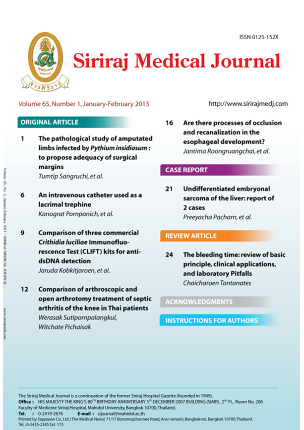Are There Processes of Occlusion and Recanalization in the Esophageal Development?
Keywords:
Esophageal atresia, stenosis, occlusion, recanalizationAbstract
Background: Esophageal atresia (EA) or stenosis is well known among the congenital abnormalities of the esophagus
which may result from the failure or incomplete recanalization after solid stage during the 8th week of human development
or deviation of the tracheo-esophageal septum. The occlusion and recanalization theory of gut development cannot explain
some types of esophageal atresia.
Objective: To study the serial section of continuous stages of esophageal development of chick embryos from related human
Carnegie stages 14-23, observe histologically whether there are occlusion and recanalization processes, at which stages and
to calculate the mitotic and apoptotic indices of the epithelial lining of the esophageal lumen as well as measuring the lumen
areas of each stage of esophageal development.
Methods: The fertilized Leghorn hen eggs (Gallus domesticus) were incubated at different time intervals to gain five embryos
for each developing stage 14-23. They were processed histologically into serial sections after the total bodies were
photographed. The serial sections were observed at the esophageal area by one skipped five sections technique. The length
and lumen area were measured, total epithelial cell count, mitotic and apoptotic cell counts were performed and the mitotic
and apoptotic indices were calculated.
Results: The lengths of the esophagus increased with advanced age from 126.80 ± 3.03 μm at stages 14 to 7, 234.80 ± 396.62
µm at stage 23. The lumen areas decreased from stages 14-16 and increased from stages 17-23. There was no evidence of
occlusion at any stage. At the stages of increasing the lumen area there was also no evidence of vacuole formation. The
mitotic indices decreased from stages 15-20 and were constant from stage 21-23, which showed no correlation with the
lumen area. The apoptotic index was highest at stage 16 which also showed no correlation with the process of recanalization.
Conclusion: By studying in the continuous stages of esophageal development, we could not demonstrate histologically the
occuluded esophageal lumens, or vacuolation of the lumens at any stage. In the same way, the mitotic and apoptotic indices
show no correlation with the lumen area. These results lead to the conclusion that processes of occlusion and recanalization
never occur in the normal esophageal development.
Downloads
Published
How to Cite
Issue
Section
License
Authors who publish with this journal agree to the following conditions:
Copyright Transfer
In submitting a manuscript, the authors acknowledge that the work will become the copyrighted property of Siriraj Medical Journal upon publication.
License
Articles are licensed under a Creative Commons Attribution-NonCommercial-NoDerivatives 4.0 International License (CC BY-NC-ND 4.0). This license allows for the sharing of the work for non-commercial purposes with proper attribution to the authors and the journal. However, it does not permit modifications or the creation of derivative works.
Sharing and Access
Authors are encouraged to share their article on their personal or institutional websites and through other non-commercial platforms. Doing so can increase readership and citations.











